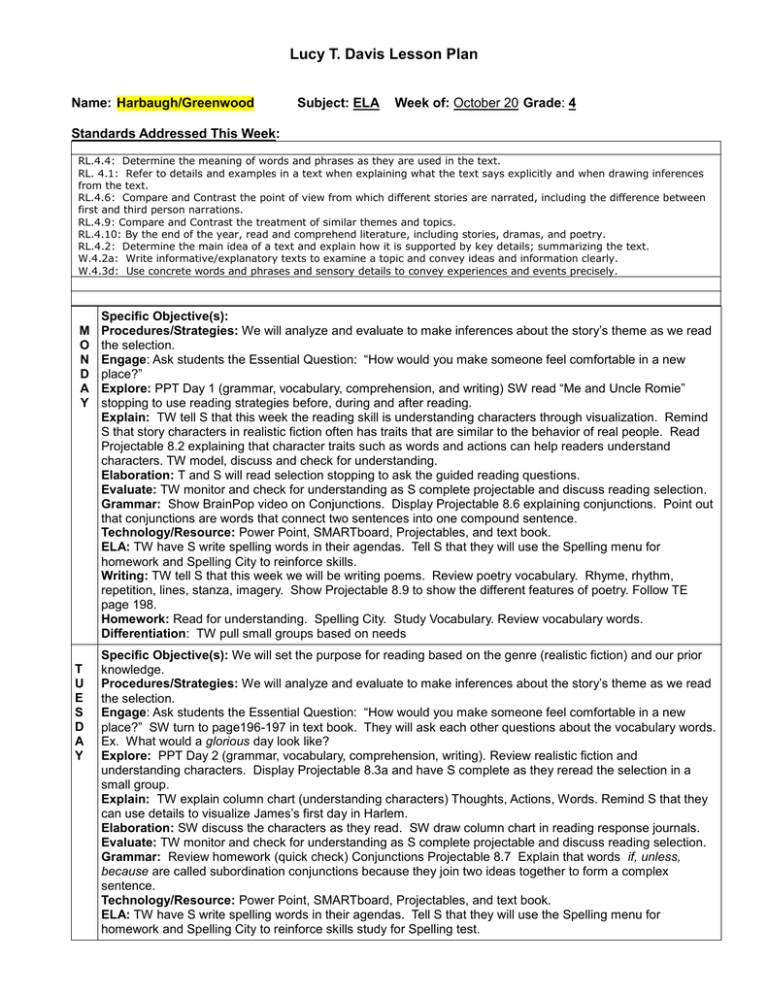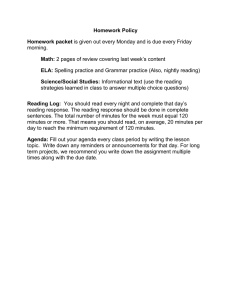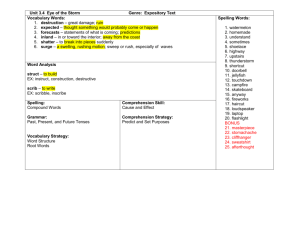Lucy T. Davis Lesson Plan
advertisement

Lucy T. Davis Lesson Plan Name: Harbaugh/Greenwood Subject: ELA Week of: October 20 Grade: 4 Standards Addressed This Week: RL.4.4: Determine the meaning of words and phrases as they are used in the text. RL. 4.1: Refer to details and examples in a text when explaining what the text says explicitly and when drawing inferences from the text. RL.4.6: Compare and Contrast the point of view from which different stories are narrated, including the difference between first and third person narrations. RL.4.9: Compare and Contrast the treatment of similar themes and topics. RL.4.10: By the end of the year, read and comprehend literature, including stories, dramas, and poetry. RL.4.2: Determine the main idea of a text and explain how it is supported by key details; summarizing the text. W.4.2a: Write informative/explanatory texts to examine a topic and convey ideas and information clearly. W.4.3d: Use concrete words and phrases and sensory details to convey experiences and events precisely. M O N D A Y T U E S D A Y Specific Objective(s): Procedures/Strategies: We will analyze and evaluate to make inferences about the story’s theme as we read the selection. Engage: Ask students the Essential Question: “How would you make someone feel comfortable in a new place?” Explore: PPT Day 1 (grammar, vocabulary, comprehension, and writing) SW read “Me and Uncle Romie” stopping to use reading strategies before, during and after reading. Explain: TW tell S that this week the reading skill is understanding characters through visualization. Remind S that story characters in realistic fiction often has traits that are similar to the behavior of real people. Read Projectable 8.2 explaining that character traits such as words and actions can help readers understand characters. TW model, discuss and check for understanding. Elaboration: T and S will read selection stopping to ask the guided reading questions. Evaluate: TW monitor and check for understanding as S complete projectable and discuss reading selection. Grammar: Show BrainPop video on Conjunctions. Display Projectable 8.6 explaining conjunctions. Point out that conjunctions are words that connect two sentences into one compound sentence. Technology/Resource: Power Point, SMARTboard, Projectables, and text book. ELA: TW have S write spelling words in their agendas. Tell S that they will use the Spelling menu for homework and Spelling City to reinforce skills. Writing: TW tell S that this week we will be writing poems. Review poetry vocabulary. Rhyme, rhythm, repetition, lines, stanza, imagery. Show Projectable 8.9 to show the different features of poetry. Follow TE page 198. Homework: Read for understanding. Spelling City. Study Vocabulary. Review vocabulary words. Differentiation: TW pull small groups based on needs Specific Objective(s): We will set the purpose for reading based on the genre (realistic fiction) and our prior knowledge. Procedures/Strategies: We will analyze and evaluate to make inferences about the story’s theme as we read the selection. Engage: Ask students the Essential Question: “How would you make someone feel comfortable in a new place?” SW turn to page196-197 in text book. They will ask each other questions about the vocabulary words. Ex. What would a glorious day look like? Explore: PPT Day 2 (grammar, vocabulary, comprehension, writing). Review realistic fiction and understanding characters. Display Projectable 8.3a and have S complete as they reread the selection in a small group. Explain: TW explain column chart (understanding characters) Thoughts, Actions, Words. Remind S that they can use details to visualize James’s first day in Harlem. Elaboration: SW discuss the characters as they read. SW draw column chart in reading response journals. Evaluate: TW monitor and check for understanding as S complete projectable and discuss reading selection. Grammar: Review homework (quick check) Conjunctions Projectable 8.7 Explain that words if, unless, because are called subordination conjunctions because they join two ideas together to form a complex sentence. Technology/Resource: Power Point, SMARTboard, Projectables, and text book. ELA: TW have S write spelling words in their agendas. Tell S that they will use the Spelling menu for homework and Spelling City to reinforce skills study for Spelling test. Writing: Tell S that good writers choose their words carefully. The right sensory words can create vivid pictures in the readers mind. Read the example on page T199. Tell S to listen to how the writer used sensory words to make the statement more interesting. Use practice book page 96 as guided practice. Let S look back in their previous writing to add sensory words to improve their writing. Homework: Read for understanding. Spelling City. Study Vocabulary. 1-5 Comprehension questions. Differentiation: TW pull small groups based on needs W E D N E S D A Y T H U R S D A Y F R I D A Y Specific Objective(s): Procedures/Strategies: We will work in cooperative groups to increase our knowledge of reading comprehension. Engage: Tell S that they will be working in cooperative groups to practice different skills. Explore: TW go over cooperative group rules and expectations as S rotate groups. Explain: TW explain the different work stations to the students. Tell the S that they will have 15 minutes to complete the stations. 1. Guided reading (comparing/contrasting) 2. Computer (compass) 3. Poetry 4. cursive Elaboration: SW complete differentiated activities while rotating through stations. Evaluate: TW monitor and check for understanding as S rotate stations every 13 minutes. Technology/Resource: computer and headphones, Venn Diagram, Poetry elements Homework: comprehension 6-10 Specific Objective(s): Procedures/Strategies: Engage: Read aloud The Relatives Came. Discuss similarities and differences of the two stories. Explore: PPT Day 3 (grammar, vocabulary, comprehension, writing). Review vocabulary and spelling words. Review comprehension questions. Display Projectable 8.4 Use the column chart to analyze character traits. Explain: Tell S that readers can analyze character traits by asking, “Would this character really do or say this? Is this how a real person would act or feel? Elaboration: SW create a collage of their favorite place to visit with relatives or friends. Share with class. Evaluate: TW monitor and check for understanding as S complete projectable and discuss reading selection. Grammar: Display Projectable 8.8 Correlative Conjunctions. Either/or, neither/nor, both/and. Technology/Resource: Power Point and SMARTboard ELA: Tell S that they will use the Spelling menu for homework and Spelling City to reinforce skills. Writing: SW write a poem about either a place, character or event from the story. Use projectable 8.10 for planning. Homework: Read for understanding. Study for Vocabulary and Story assessment. Differentiation: TW pull small groups based on needs. Specific Objective(s): Procedures/Strategies: We will assess our knowledge on vocabulary and comprehension questions related to the story. Engage: Review vocabulary words and listen to story before taking assessments. Explore: TW discuss the different parts of the story and have S stop to summarize each section. Explain: TW explain the directions to the test. TW discuss test taking strategies as S take the test. Underline key words, reference the text, and eliminate wrong answer choices… Evaluate: TW monitor and check for understanding as S take assessments. Grammar: Review conjunctions. Writing: Explain that writers can use words that signal comparisons and contrasts. Discuss words such as both, alike, same, and similar to show comparisons, and on the other hand, unlike, different, and in contrast to show differences. Technology/Resource: SMARTboard, story and vocabulary assessments. Homework: Read for understanding.

